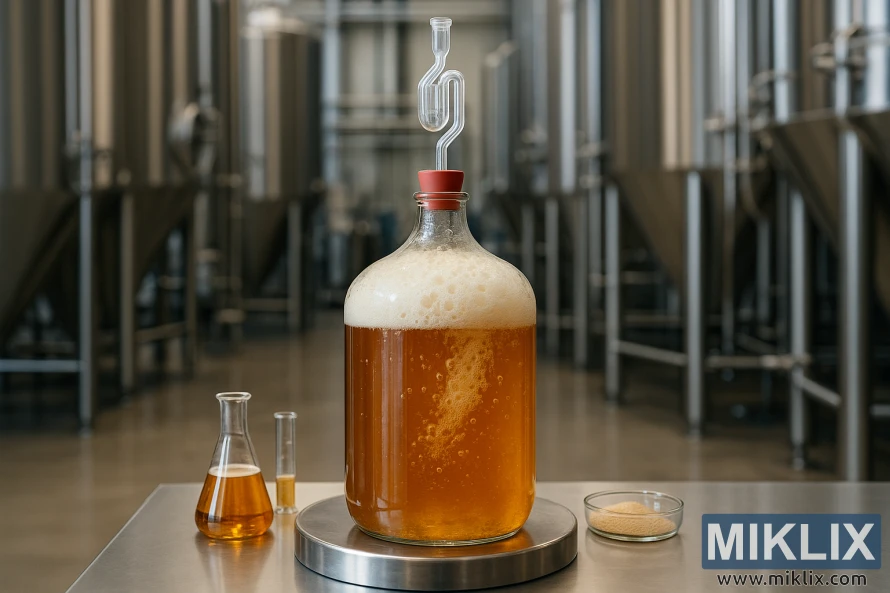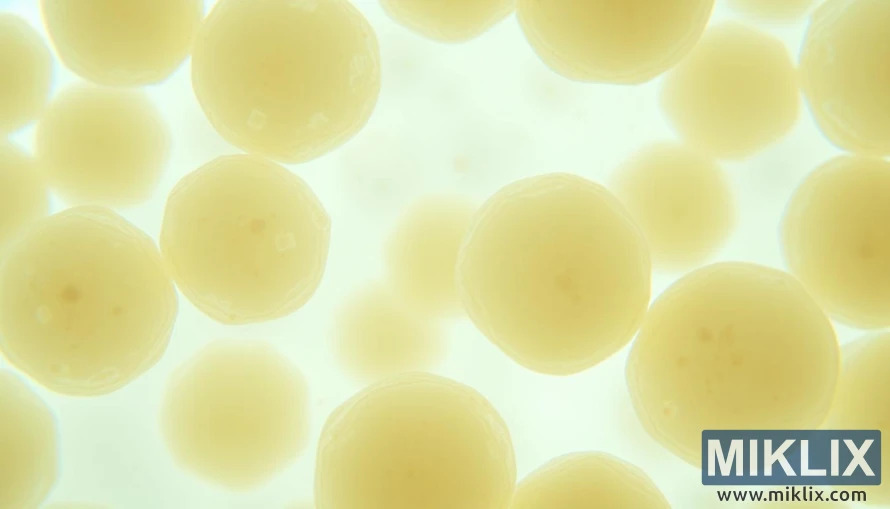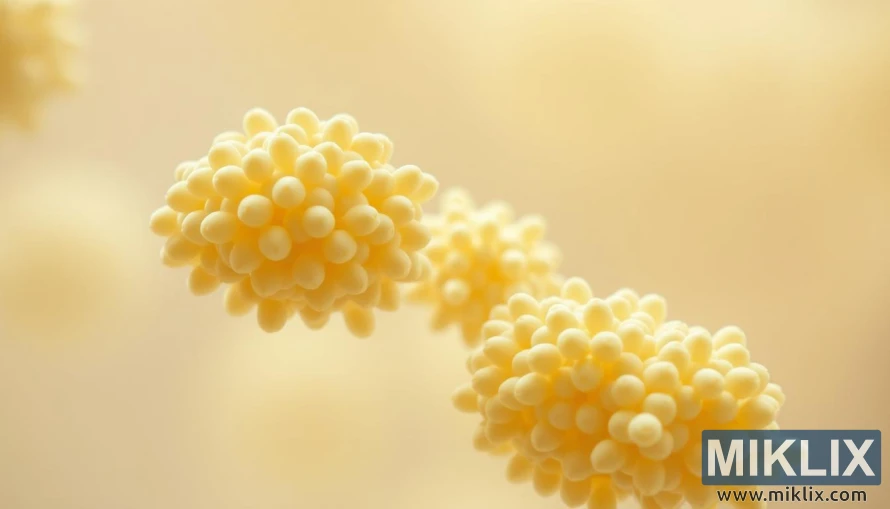Fermenting Beer with Fermentis SafLager W-34/70 Yeast
Published: August 19, 2025 at 7:30:40 AM UTC
Fermentis SafLager W-34/70 Yeast is a dry lager yeast strain, rooted in the Weihenstephan tradition. It is distributed by Fermentis, a part of Lesaffre. This sachet-ready culture is ideal for both homebrewers and professional breweries. It offers a stable, high-viability alternative to liquid cultures for brewing traditional lagers or hybrid styles.

SafLager W-34/70 is available in various sizes, from 11.5 g packets to 10 kg bags. Reviews often praise its long shelf life and clear storage guidelines. It can be stored for 36 months, with specific temperature ranges to maintain viability. The product label lists Saccharomyces pastorianus and emulsifier E491, ensuring purity and viability standards from Fermentis are met.
Lesaffre's manufacturing claims highlight robust performance, even under cold pitching or no-rehydration conditions. This appeals to brewers seeking consistent attenuation and clean lager profiles. This article will explore fermentation performance, sensory outcomes, and comparisons to liquid strains. It will also provide hands-on advice for brewers using this dry lager yeast.
Key Takeaways
- Fermentis SafLager W-34/70 Yeast is a dry lager yeast with Weihenstephan heritage suited for clean lager fermentation.
- Available in sizes from 11.5 g to 10 kg, making it practical for home and commercial brewing.
- Technical specs show high viability and purity; product contains Saccharomyces pastorianus and E491.
- Manufacturer reports strong performance with cold or no-rehydration pitching options.
- This SafLager W-34/70 review will cover fermentation traits, sensory notes, and brewing adjustments for brewers.
Why Fermentis SafLager W-34/70 Yeast is Popular for Lager Brewing
Brewers value W-34/70 for its historical significance in the Weihenstephan region. It is known for delivering consistent results across traditional lager styles. This reputation has made it a favorite among commercial breweries and homebrewers.
The strain's flavor profile is a significant factor in its popularity. Fermentis notes that it produces a balanced mix of floral and fruity esters. This clean lager yeast character enhances malt and hop flavors without overpowering them.
Its versatility and resilience further contribute to its appeal. W-34/70 can handle various pitching and rehydration methods, making it adaptable to different brewing workflows. Its ability to thrive under both direct pitching and careful rehydration is noteworthy.
Practical packaging and high viability make W-34/70 suitable for large-scale brewing. Available in sizes ranging from small sachets to large bricks, it offers strong cell counts and a long shelf life. These features cater to both cellar operators and hobbyists, increasing its popularity.
Community feedback reinforces the yeast's reliability. Brewing forums and user logs highlight its consistent performance across temperatures and generations. This dependable nature encourages brewers to make W-34/70 their go-to lager yeast.
The combination of historical significance, flavor profile, operational ease, and widespread endorsement solidifies W-34/70's position. Many brewers choose Fermentis SafLager W-34/70 for its ability to deliver consistent lager results.
Fermentis SafLager W-34/70 Yeast
SafLager W-34/70 is a dry Saccharomyces pastorianus W-34/70 strain, widely used in lager production. It traces its lineage to Weihenstephan and Frohberg groups. This gives it reliable cold fermentation behavior and clean lager profiles.
Key specifications of SafLager W-34/70 include an apparent attenuation of 80–84% and a viable concentration greater than 6.0 × 10^9 cfu/g. Purity standards exceed 99.9%. The Fermentis technical data sheet also lists quantification limits for lactic and acetic bacteria, Pediococcus, wild yeasts, and total bacteria.
Dosage guidance from Lesaffre recommends 80–120 g/hl at 12–18°C (53.6–64.4°F) for industrial brews. Homebrewers can scale this recommendation to match typical pitch rates by weight per volume and gravity. Adjustments should be made to reach similar cell counts per milliliter.
Storage rules affect activity and shelf life. When stored below 24°C, shelf life extends up to six months. Below 15°C, it improves beyond six months, with a production shelf life of 36 months. Opened sachets should be resealed, kept at about 4°C, and used within seven days as stated on the Fermentis technical data sheet.
Product support from Lesaffre includes a downloadable technical sheet and documented quality controls for production. The manufacturer emphasizes continuous improvement and microbiological purity. This is to protect fermentation performance when using SafLager W-34/70.
Fermentation performance and attenuation characteristics
Fermentis indicates an apparent attenuation of 80-84% for W-34/70, categorizing it as medium-to-high for lager yeasts. Fermentis conducted lab trials with a standard wort, starting at 12°C and increasing to 14°C after 48 hours. They monitored alcohol production, residual sugars, flocculation, and fermentation kinetics of W-34/70.
Homebrewer logs reveal a range of attenuation levels for W-34/70 in real-world batches. Some institutional tests reported near 73% attenuation, while hobbyist fermentations often reached the low to mid-80s. A documented single-batch went from 1.058 OG to 1.010 FG, achieving an attenuation of about 82.8%.
Practical fermentations show that W-34/70 attenuation is influenced by various factors. These include mash temperature, pitch rate, yeast health, wort composition, oxygenation, and the fermentation temperature profile. These elements can significantly alter the final attenuation from the manufacturer’s stated range.
- Mash temp: higher mash temps leave more dextrins and lower apparent attenuation.
- Pitch rate and yeast vitality: underpitching or stressed yeast can reduce attenuation.
- Oxygenation: inadequate oxygen limits fermentation kinetics W-34/70 and sugar uptake.
- Wort gravity and composition: high dextrin levels yield fuller body and lower apparent attenuation 80-84% in practice.
- Fermentation temperature: cooler, slower ferments tend to show reduced attenuation compared to the Fermentis lab profile.
The level of attenuation impacts the beer's balance. Higher W-34/70 attenuation results in a drier finish and can enhance hop bitterness, creating a sharp, German Pils-like profile. Lower attenuation, on the other hand, leads to a fuller mouthfeel and perceived sweetness, appealing to some brewers for specific lager styles.
To achieve desired outcomes, brewers can adjust mash schedules, oxygenation, and pitching routines. Using the strain’s apparent attenuation 80-84% as a guide helps set expectations. Field data, though, remind brewers to anticipate batch-to-batch variability.

Recommended fermentation temperatures and schedules
Adhere to Fermentis' suggested W-34/70 fermentation temperature range of 12-18°C. This range is optimal for primary fermentation and flavor development, according to Fermentis.
For traditional lagers, aim for the lower end of this range. A typical lager fermentation schedule involves a cold start at around 12°C. This is followed by a slight increase after two days. Fermentis suggests starting at 12°C for 48 hours, then increasing to 14°C to maintain activity.
Some brewers have successfully fermented and lagered at roughly 48°F (8.9°C). This approach can enhance clarity and reduce esters. Yet, Fermentis emphasizes the importance of 12-18°C for primary fermentation to achieve balance in attenuation and aroma.
Here are some practical schedules to consider:
- Cold pitch to 12°C, rest for 48 hours, then free-rise or ramp to 14–15°C for main fermentation.
- Start at 12°C with a controlled rise of 1–2°C per day until final gravity approaches target.
- Primary at 12–15°C, then extended cold maturation (lagering) at 0–4°C to clear sulfur and smooth profile.
Follow Fermentis' guidelines on yeast dosage and handling. They recommend an industrial dosage of 80–120 g/hl. It's wise to conduct pilot trials when adjusting your lager fermentation schedule or experimenting with new temperatures.
Be vigilant for signs of slow activity and make adjustments carefully. Opt for gradual increases in temperature, such as free-rise options or slow ramps. This approach helps protect yeast health and ensures clean sensory outcomes within the 12-18°C Fermentis range.
Pitching methods: direct pitching versus rehydration
Brewers have two options when using Fermentis SafLager W-34/70. Each method aligns with Fermentis' technical guidelines, catering to various brewing scenarios.
Direct pitch dry yeast involves sprinkling the sachet over the wort's surface at or above fermentation temperature. For optimal results, add yeast early in the filling process. This ensures cells hydrate at the wort's temperature and prevents clumping.
- Sprinkle evenly to cover the whole surface.
- Start oxygenation and temperature control promptly to support cell activity.
- Direct pitching saves time and cuts the number of handling steps.
Rehydrate Fermentis yeast when wort stress, high gravity, or long storage might lower initial viability. Use at least ten times the yeast weight in sterile water or boiled-and-hopped wort at 15–25°C (59–77°F).
- Sprinkle yeast into the water or cooled wort.
- Rest 15–30 minutes, then stir gently to form a creamy slurry.
- Pitch the cream into the fermenter and follow standard oxygenation.
Fermentis notes that W-34/70 pitching methods are robust against cold or no-rehydration conditions. This adaptability allows brewers to align their technique with their workflow.
Practical considerations are key. Direct pitch dry yeast minimizes contamination risk by reducing transfers. Rehydration, on the other hand, enhances initial cell viability for stressed worts or high-gravity beers. It can also facilitate smoother fermentation starts.
Adhere to the packaged dosage and scale for batch size. Industrial guidelines suggest 80–120 g/hl as a reference. Adjust for homebrew volumes, wort gravity, and oxygenation to ensure a healthy fermentation start.
Flocculation and sedimentation behavior
Fermentis classifies W-34/70 as a flocculating strain, which explains why many brewers see quick clearing. Manufacturer data and academic papers link cell aggregation to flocculin proteins. These proteins bind yeast together when simple sugars fall.
Practical reports note dense, tight sediment and the formation of flocculation balls during transfer and cold conditioning. These traits shorten conditioning time and make racking easier for many lager recipes.
Some users document powdery or non-flocculent batches. This variability can arise from mutations in FLO genes, production differences at the supplier, or contamination with non-flocculent yeasts.
- Monitor sedimentation time SafLager during conditioning to catch atypical behavior early.
- Use quality-control plating or sequencing when reuse or propagation is planned.
- Cold-crash and gentle filtration help manage clarity if yeast flocculation behavior is weak.
Flocculation timing ties directly to yeast metabolism. Yeast flocculation behavior typically ramps up after respiratory sugars drop. This makes sedimentation predictable in well-managed ferments.
For harvest and reuse, strong W-34/70 flocculation simplifies slurry collection. For uncertain batches, check sedimentation time SafLager and keep a propagation plan. Include microscopy or viability checks.

Alcohol tolerance and suitable beer styles
Fermentis SafLager W-34/70 has an alcohol tolerance of 9–11% ABV. This range is ideal for most traditional lagers. It prevents yeast stress in normal-strength batches.
Homebrewers have found that this yeast can achieve higher apparent attenuation in high-gravity beers. This results in drier finishes. Adjusting mash temperature and oxygenation can help the yeast handle richer worts.
Recommended beer types include Pilsner, Munich Helles, Märzen, Dunkel, and Bock. These styles benefit from the strain’s clean ester profile and steady fermentation character.
For pilsners, a softer mouthfeel is often desired. Lower attenuation strains can achieve this. Yet, many brewers prefer W-34/70 for its crisp, dry finishes. Adjusting mash schedules to increase fermentable sugars can add body.
- Pilsner and Bohemian-style lagers — crisp, dry results when W-34/70 alcohol tolerance is approached.
- Munich Helles and Märzen — balanced ester presence suits malt-forward lagers.
- Dunkel and traditional Bock — works well with higher original gravities when stepped pitching and oxygenation are used.
Mash temperature impacts fermentability. Higher temperatures result in fuller body, which can temper the yeast’s attenuation. For very high-gravity batches, consider stepped pitching, extra oxygen, and vigorous yeast health practices. This ensures the yeast can handle the lager styles for W-34/70.

Common sensory outcomes and off-flavor considerations
Fermentis SafLager W-34/70 typically produces a clean, malty base with subtle floral and fruity esters. Many brewers appreciate its high drinkability and neutral profile, making it ideal for classic pilsners and Helles.
Users have reported off-flavors such as sulfurous notes, woody tones, or a heavy mouthfeel. These issues can vary by batch and are influenced by how the yeast was stored or propagated before pitching.
Sulfur with W-34/70 can manifest early in fermentation with a faint rotten-egg aroma. Fortunately, this usually diminishes with proper lagering and cold conditioning. Extended cold storage often helps to tame transient off-notes.
Several factors can impact W-34/70 flavors. These include oxygenation at pitching, fermentation temperature swings, mash composition, and yeast health. Poor storage or stressed yeast can increase the likelihood of off-flavors.
To mitigate these issues, maintain steady, low lagering temperatures, pitch healthy yeast at the recommended rate, and ensure adequate oxygen at the start of fermentation. These steps help minimize sulfur and other atypical notes.
- Follow Fermentis temperature and pitching guidance.
- Allow extra lager time for sulfurous aromas to dissipate.
- Store dry yeast in cool, dry conditions to preserve vitality.
- Monitor mash profile and oxygenation to support clean W-34/70 flavors.
Comparing batches can help determine if off-flavors are one-off issues or consistent. Some brewers prefer liquid or house strains for subtle differences. Yet, many find W-34/70 reliably clean when handled correctly.
Comparing Fermentis W-34/70 to liquid and other dry strains
Brewers often weigh W-34/70 vs liquid yeast when choosing a strain for lagers. Genetic studies and forum reports show W-34/70 differs from certain liquid lab strains such as Wyeast 2124. This means flavor and performance may not match exactly, even if results look similar at first.
On practical grounds, dry yeast comparisons highlight clear trade-offs. Dry strains like W-34/70 offer long shelf life, simple storage, and consistent pitching rates. Liquid cultures deliver a wider strain library and tighter fidelity to a lab’s original profile.
Performance comparisons reveal mixed opinions. Many find W-34/70 produces a clean, crisp finish with strong flocculation. Other brewers say some liquid strains yield fewer subtle off-flavors and more repeatable character from batch to batch.
Production and packaging can affect outcomes. Dry yeast manufacturing has been linked to rare mutations or package-level contaminants that change attenuation or flocculation. Such variability shows up in anecdotal reports during head-to-head trials.
- Fermentis vs Wyeast debates focus on control versus nuance.
- Dry yeast comparisons often favor convenience and cost savings.
- W-34/70 vs liquid yeast notes point to sensory differences and lab fidelity.
For brewers changing strains, the smart step is a side-by-side pilot. Small-scale trials reveal how attenuation, aroma, and mouthfeel shift with W-34/70 compared to a chosen liquid alternative. Use those results to guide full-brew decisions.
Yeast health, propagation, and reuse strategies
Healthy yeast is essential for clean and predictable lager fermentations. For high-gravity or larger batches, plan W-34/70 propagation to achieve the right cell count before pitching. Fermentis recommends industrial dosing at 80–120 g/hl; homebrewers should scale their starters or combine sachets as needed.
Building yeast starters in steps is best for lager yeast. Begin with a small, oxygenated starter at low gravity, then increase volume or gravity over 24–48 hours. This approach reduces cell stress and enhances fermentation kinetics.
Many brewers reuse dry yeast to save money and reduce waste. Results vary: some achieve clean results for 4–10 repitches, while others notice changes in flocculation or aroma sooner. Monitor sedimentation, attenuation, and sensory profile with each generation.
When harvesting for reuse, only take yeast from clean, healthy fermentations. Minimize oxygen exposure during transfer and store yeast cold and sanitary. If off-flavors or slowed kinetics appear, stop repitching and use fresh rehydrated yeast or a new sachet.
- Check viability with a simple methylene blue or Trypan test before repitching.
- Observe flocculation and sedimentation; big shifts suggest population change.
- Limit generations when brewing delicate lagers to protect flavor fidelity.
Consider lab analysis or plating if unexpected traits emerge. These tests reveal contamination or population dominance that simple tasting may miss. For flagship lagers where consistency is key, many brewers prefer liquid yeast or freshly rehydrated dry yeast over repeated repitches.
Balance cost and quality by using yeast starters for lager yeast when scaling and reserving reuse dry yeast for less critical batches. Proper hygiene, gentle handling, and careful monitoring make W-34/70 propagation and reuse viable tools for skilled brewers.
Sanitation, contamination risks, and quality control
Ensure work surfaces, utensils, and hands are clean when handling dry yeast. Use sterile water for rehydration and sanitize scissors for opening the sachet. This aseptic technique minimizes contamination risks during transfer.
Follow Fermentis guidelines for rehydration and pitching temperatures. Adhering to these steps helps maintain yeast vitality and ensures consistent cell performance. Poor handling can lead to changes in flocculation or off-flavors, mimicking contamination.
Fermentis purity specs reveal extremely low counts of harmful bacteria and wild yeasts. The technical sheet confirms compliance with pathogenic microorganism limits. These purity figures instill confidence in the product, provided storage and handling guidelines are followed.
Organize incoming stock and verify batch numbers and best-before dates. Rotate inventory to use older packs first. Purchase from reputable retailers and store sachets at recommended temperatures. This maintains viability and reduces W-34/70 contamination risks in aging stock.
If unexpected aromas, poor flocculation, or inconsistent attenuation are detected, investigate before attributing it to the strain. Verify storage history and inspect packaging. For persistent or unusual sensory issues, consider plating samples or sending them to an accredited lab for microbiological analysis. This confirms whether contamination or production variance is present.
Implement these routine quality control steps to safeguard beer quality.
- Sanitize rehydration vessels and tools.
- Follow Fermentis purity specs and rehydration guidance.
- Track batch numbers and production dates.
- Store at recommended temperatures and rotate stock.
- Send samples to a lab if suspicious fermentation behavior appears.
By practicing these measures, yeast health is maintained, and contamination risks are reduced. Clear record-keeping aids in tracing problems and supports confident yeast quality control across brews.

Practical brewing adjustments when using W-34/70
W-34/70 is a robust lager strain known for high attenuation. To manage final gravity and mouthfeel, increase the saccharification rest to about 152°F (67°C). This step creates more dextrins, leading to a fuller body. It does so without affecting hop or malt character.
Pitch rate and oxygenation are critical for clean fermentations. Ensure your pitching rate aligns with batch size and gravity. Also, oxygenate the wort adequately before pitching. Proper oxygenation helps reduce stress-related sulfur and solvent notes when using W-34/70.
- Fermentation profile: keep active fermentation between 12–18°C to retain crisp lager traits.
- Free-rise and ramp-up: use conservative increases to avoid off-flavors during vigorous activity.
- Cold lagering: extend cold conditioning to help W-34/70 clean up sulphury tones and polish the profile.
When tweaking lager recipes, expect a drier finish in light styles like pilsners. Consider adding specialty malts, crystal, or increasing the mash temp for darker lagers and bocks. Be mindful of hopping rates, as a drier beer can amplify hop bitterness.
Conditioning and handling play a significant role in clarity and yeast recovery. Allow for extended lagering or cold-crash periods to settle heavy flocculation. When transferring or harvesting yeast, account for strong sediment to avoid racking solids into bright beer.
Small procedural shifts can lead to significant improvements. Focus on mash schedule adjustments, controlled oxygenation, and deliberate temperature control. These tweaks are essential for achieving balanced attenuation, mouthfeel, and clean flavor with W-34/70.
Troubleshooting fermentation issues with W-34/70
When stuck fermentation with W-34/70 occurs, start with the fundamentals. Examine the pitch rate, yeast viability, wort gravity, and oxygenation levels. If yeast numbers are low, introduce gentle oxygenation and slightly warm the fermenter. This should align with the strain's optimal temperature range. If fermentation doesn't restart, re-pitch with fresh, healthy Saccharomyces pastorianus to prevent yeast stress.
Slow attenuation can be due to several factors. First, ensure the mash temperature and wort fermentability are correct. Lower mash temperatures can result in more fermentable sugars, leading to higher attenuation. Adjust your mash schedule to retain more dextrins for a fuller body. Monitor original gravity and attenuation targets to identify trends in your batches.
To address off-flavor issues, pinpoint the cause. Sulfur notes often diminish with extended cold conditioning and proper lagering. Woody or unusual chemical flavors might indicate poor sanitation, storage issues, or packaging defects. Conduct a control batch with a different yeast or fresh W-34/70 to determine if the yeast or process is at fault.
Changes in flocculation, such as powdery sediment or non-flocculent yeast, could signal mutations, contamination, or batch variations. Avoid repitching from suspect batches. If problems persist, send samples for plating. Reach out to Fermentis support for consistent flocculation anomalies across multiple batches.
Implement a checklist for systematic W-34/70 troubleshooting:
- Verify pitch rate, viability, and oxygenation before fermentation.
- Confirm mash profiles and wort fermentability for any deviation in attenuation.
- Extend cold conditioning to reduce sulfur and other transient notes.
- Review sanitation, storage, and packaging when off-flavor fixes are unclear.
- Stop repitching from suspect batches; run side-by-side trials with alternate strains.
Consider replacing the strain if repeated sensory defects, erratic attenuation, or poor flocculation occur. Test a different dry lager strain or a reputable liquid culture in side-by-side brews. This will help you compare results before making a permanent switch.
Conclusion
Fermentis SafLager W-34/70 offers a solid, budget-friendly base for lager brewing. This summary emphasizes its 80–84% target attenuation and a 12–18°C fermentation range. It also boasts a long shelf life, ideal for Pilsner, Helles, Märzen, Dunkel, and Bock styles with proper handling.
Its strengths include a clean fermentation profile and a pleasant floral/fruity balance. It offers flexible pitching options and reliable packaging for both small and large operations. To maximize its benefits, pair it with careful temperature control and mash design. Choose proper rehydration or direct pitching to achieve the desired attenuation and sensory outcomes.
Despite its advantages, brewers should be aware of some caveats. There are reports of batch variability, occasional off-flavors, and shifting flocculation. A wise strategy is to test new lots, compare them with liquid strains, and maintain strict sanitation and quality control. This helps to identify any production or contamination issues.
In summary, the SafLager review concludes that W-34/70 is a reliable starting point for lager brewers looking for convenience and value. Monitor fermentation closely, adjust recipes as necessary, and conduct small trials before scaling up. This ensures the strain meets your sensory and attenuation goals.
Further Reading
If you enjoyed this post, you may also like these suggestions:
- Fermenting Beer with White Labs WLP036 Dusseldorf Alt Ale Yeast
- Fermenting Beer with CellarScience Kölsch Yeast
- Fermenting Beer with Fermentis SafAle WB-06 Yeast
